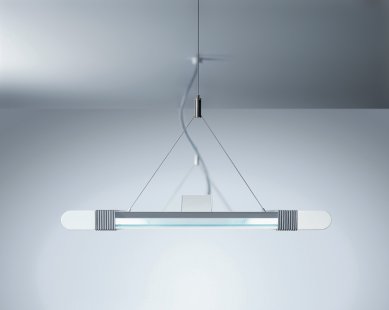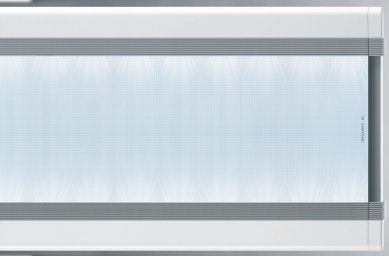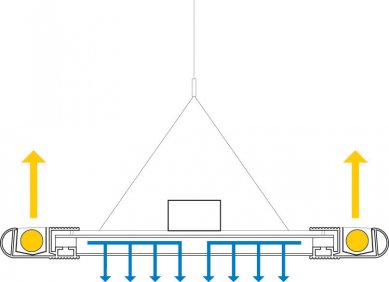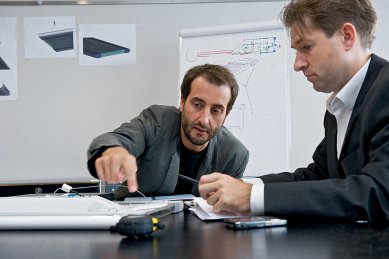
Past and Future – Christopher Redfern on Timeless Design
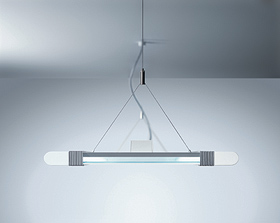 |
| The original, elegant design of the Aero luminaire was refined in the Aero II Hybrid. The aim was to create an optically lightweight light to give the impression of floating. |
With his group Memphis, which he founded, he broke all the rules of functionalism. The prevailing functionality of design objects was challenged. At the same time, he designed, together with the industry, technical products that were influenced by his complex way of thinking. With his design of the Aero office pendant light, for example, Ettore Sottsass managed to create an exceptional product at the end of the 90s – using creative and technological aspects. Together with his young collaborator Chris Redfern, Sottsass created a luminaire that convinced with its classic timeless design. Thanks to the so-called waveguide technology, this product started a new chapter in the world of lighting technology. For the first time, it was possible to place highly efficient fluorescent lamps using the principle of light control into an extremely flat luminaire. The lamps are positioned on the sides, and the light is precisely directed using a computer-controlled micro-prismatic structure.
The Aero luminaire has won several design awards, and for Zumtobel, this product also represented a huge success in terms of economic aspects, as it served as a template for countless flat luminaires.
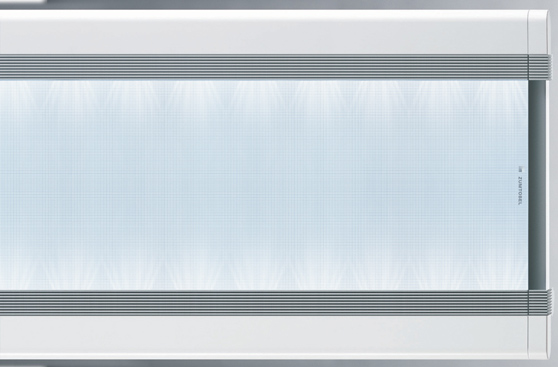 |
| The new Aero II Hybrid luminaire combines futuristic design with innovative technology. |
Ten years later, the world of lighting technology will experience a revolution thanks to a new light source based on LED technology. With increasingly higher efficiency, this little powerhouse is gradually conquering functional lighting as well. This poses the challenge of how best to incorporate these new technologies into office lighting as well. For Zumtobel, this led to two options: design a new luminaire or adapt the existing design? It quickly became clear from a development process perspective that the shape of the Aero luminaire deserved to live on. The design of the conventional Aero luminaire underwent a facelift to perfectly adapt to the new light source. Chris Redfern, designer of the Aero II and managing director of Sottsass Associati in Milan, found a convincing way to transform the existing design to be recognized and at the same time elegant, futuristic, and new.
Interview with Chris Redfern, chief designer at Sottsass, who adapted the new Aero II Hybrid to LED technology:
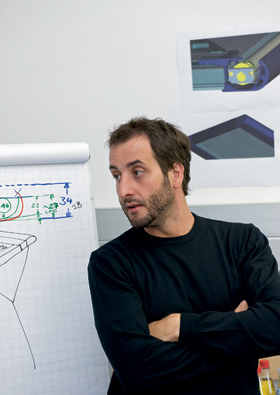 |
| Using numerous sketches, Redfern designed, together with Zumtobel, the hybrid concept of the new generation of Aero luminaires. |
I don't have any specific favorite object or project, but I find design that can survive the ages very interesting and fascinating – objects that are immortal and in a way mysterious, almost sacred. It's very difficult to design timeless objects. For example, furniture by Charles and Ray Eames can make an impression, as well as objects designed a long time ago that are still successful and capable of captivating. The same goes for the vinegar and oil cruet designed by Sottsass in the late seventies for Alessi, which is still very much in demand today. In my opinion, in addition to the aspect of fascination, it also depends on the ecological concept of design.
The new Aero luminaire is a true masterpiece. Why did you decide to preserve the existing design?
I wouldn't say that I strictly adhered to the existing design; it's more about enhancing the lighting technology and design concept. When the original Aero luminaire was designed in 1997/98, waveguide technology represented the peak of lighting technology. There was a wonderful balance between design and technology. Now comes the next chapter – the Aero II with its innovative LED technology. I wanted to use the ideas and concepts that were at the origin of the original Aero to achieve a balance between technology and design again, to retell the history and create a certain identity.
It's like designing a car: you can see that even after 20 years, it's still the same car, which has, however, been improved through new technologies and materials.
Were there any problems associated with adapting LED technology to the existing design that needed to be solved?
We had several technical challenges to solve. When using new technologies, you inevitably face difficulties at first. In this luminaire, we addressed issues related to heat dissipation, uniformity of illumination, and also how to prevent glare. Our goal was to create as harmonious and quiet lighting as possible so that people working under these lights would feel comfortable. I believe that together with the technicians and engineers at Zumtobel, we managed to create very quiet light.
 |
| LED technology enriches high-quality waveguide technology and micro-pyramid optics (MPO+) with economical and excellent lighting properties. T16 fluorescent lamps provide pleasant indirect lighting. |
What technical possibilities do you think LED technology can offer in the future for designers?
LED technology has changed many things; it is very exciting to observe how this technology is slowly becoming an important light source. The O-LED technology is also fascinating for designers. What I like about this technology is that it is very small, giving designers far more options for placing bulbs. In the past, designers had to think hard about how to hide a large luminaire or how to make it look good, but now designers and architects can focus much more on light itself and its use. Currently, we can focus much more on how to achieve a certain mood, feelings, and color changes, and how to create the lyricism of light for this comedy called “life.”
What do you think perfect light should look like?
To see perfect light, just take a look at the sky. As the sun sets in the evening and rises in the morning, it shows us when we should go to sleep or when to wake up, how the colors in the sky constantly change and what feelings they evoke in us, how we can observe the onset of a storm in the sky, how the sky darkens, and how beautiful the sky can be when it is cloaked in pink and blue tones and immersed in clouds. The sky is such a natural part of us that we often don’t even notice that it exists. Only when it has to be...
> More about the Aero II Hybrid luminaire
> Product brochure (.pdf, 3.3 MB)
> Page of Zumtobel in the catalog
The English translation is powered by AI tool. Switch to Czech to view the original text source.
